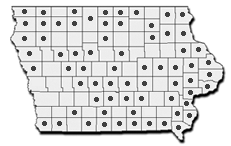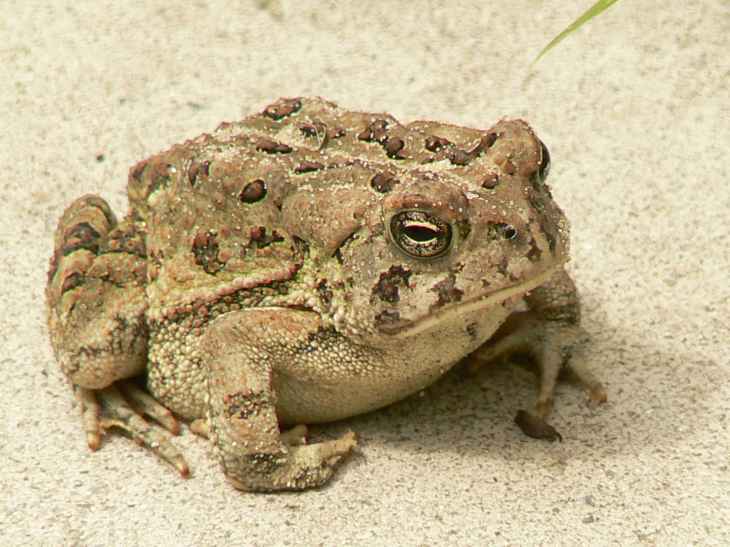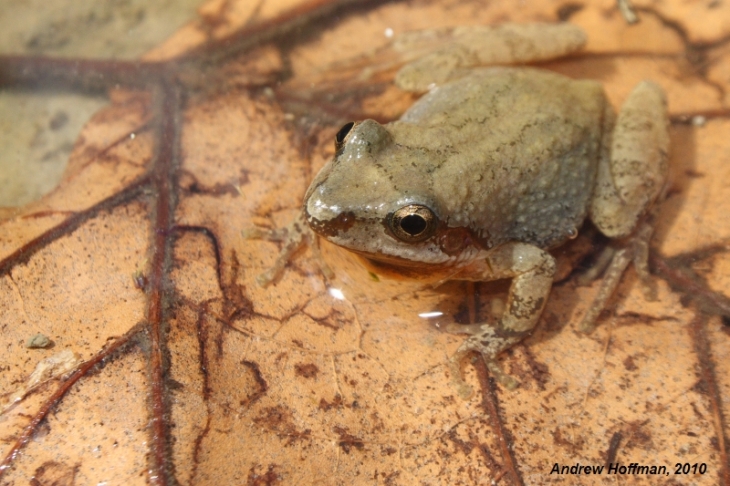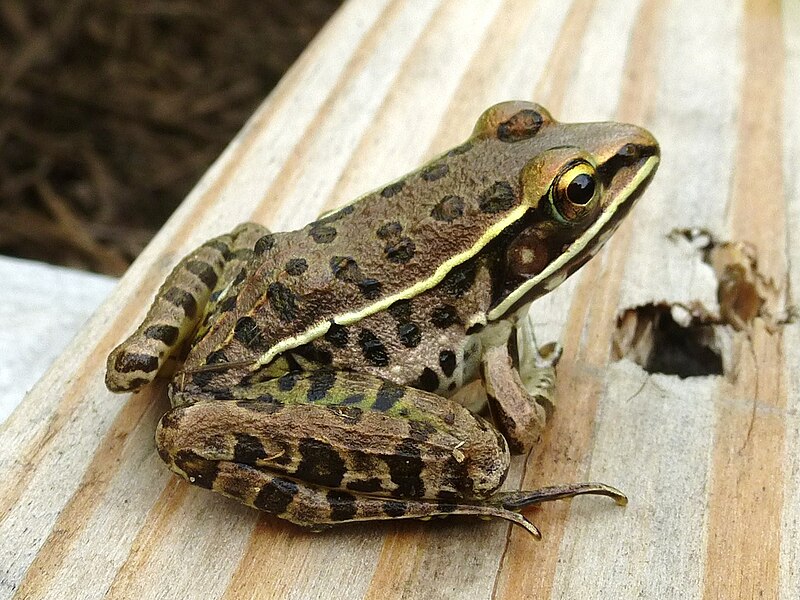***This post is a part of my series where this year I will be highlighting all of the different states native frogs and toads. Check out this page to see all of the United State’s native frogs broken down by state. ***
A frog that weighs up to 1.5 pounds?!? Read on to learn more about the frogs and toads that can be found in Iowa:
American Toad (Anaxyrus americanus)

Photo 1
The American toad is mainly nocturnal and is most active when the weather is warm and humid. During the winter, the toad will burrow deep into the ground below the frost line. As the frost line gets deeper, the toads will burrow deeper beneath the ground. They can be found statewide and is very common.

The toad has a high musical trill which can last upwards of 30 seconds. American toad is highly terrestrial and can only be found in the water for a short period while breeding and laying eggs. Below is a video that shows the American Toad calling.
Fowler’s Toad (Anaxyrus fowleri)
The Fowler’s toad is usually brown, grey, olive green and rust red in color with darkened warty spots. As these toads become adults, a pale stripe will form down its back. The belly is usually whiteish with one dark spot. These toads are only found in southeast Iowa.

Photo 2
This toad has a long, loud, high pitched W-A-A-A-H-H-H call. Listen to it in the video below! It is said that they can be mistaken for a herd of sheep calling in the night. The Fowler’s toad will make a series of quick, short hops as the American toad will make a few larger hops. The fowler’s toad will breed late spring – mid August. The female can release 7,000 -10,000 fertilized eggs which will hatch 2-7 days later.
Gray Treefrog (Hyla versicolor)
Photo 3
The grey treefrog may range in color from green to brown to grey (as shown above). During the day, they may be found sleeping on tree branches or leaves. Their toes have a sticky pad which allows them to easily climb vertically up windows, siding, trees; etc. They may be found in the eastern half of Iowa.

Female grey tree frogs may lay 1,000-2,000 eggs in clusters of 10-40. Tadpoles can be distinguished by their redish-orange tails. Male grey treefrogs have a short melodic trill that lasts only a second. They will generally call on warm and humid evenings between May & July. Below is a video of the Gray treefrog calling.
Spring Peeper (Pseudacris crucifer)
Photo 4
The spring peeper is one of Indiana’s smallest frogs measuring from 1″ to 1-1/2″. It can be distinguished by it’s dark colored “X”across its back. This frog is uncommon except in counties near the Mississippi River. They can be found in a variety of habitats and breed in almost any freshwater source.

It’s chorus of a shrill high pitched call can be heard from up to a 1/2 mile away! Listen to its call in the video below. Similar to the American toad, these frogs spend most of its time on land and only are in the water to breed and lay eggs. Like most tree frogs, the spring peeper is nocturnal and loves to hunt ants, spiders and other small insects during the evening.
Green Frog (Lithobates clamitans)

Photo 5
The Green Frog is abundant on the eastern half of Iowa. It is typically greenish-brown with dark mottling on its head, chest and under its legs. The throat color ranges to yellow for a male to white for the females.

These frogs can produce as many as 6 different calls – however the most distinctive sound is a throaty boink that sounds like a loose banjo string being plucked. Listen to the video below to hear!
Southern Leopard Frog (Lithobates sphenocephalus)
Photo 6
The southern leopard frog is a greenish brown color and has 2 yellow lines down the back and one above the lip. These frogs can be found in shallow freshwater or slightly brackish water. They are usually found a powerful jump or two away from the water, however in summer they may be found far from the water where they venture for insects. Due to their name, it is not odd that they can be found in the extreme southeastern corner of Iowa.

The southern leopard frogs call sounds like a squeaky balloon or chuckling croak. Females may deposit 3,000-5,000 eggs in cluster within the water. Listen below to hear their call.
Pickerel Frog (Lithobates palustris)
The Pickerel frog looks very similar to the Leopard frog; however the pickerel frog has 2 parallel rows of squareish spots down its back.

Photo 7
These frogs are common in the eastern 1/3 of Iowa. They are often found near ponds with dense vegetation.

As a defense the skin of the pickerel frog produces a toxic substance which makes them unappealing to most predators. Listen to the video below to hear their call. It is similar to the Northern Leopard frog, however it is shorter and faster, causing it to sound more like a finger running over tines on a comb.
Cope’s Gray Treefrog (Hyla chrysoscelis)
The Cope’s gray treefrog is smaller and smoother skinned than the gray treefrog. The gray treefrog and Cope’s gray treefrog can be difficult to tell apart during breeding while they are both mottled. However, most of the time the Cope’s gray treefrog has a solid lime green colored back.

photo 8
These frogs can be found in the south west portion of Iowa. They could easily be found throughout the state of Iowa, as it was previously assumed that Cope’s gray treefrogs and eastern gray treefrogs were the same.

Another way the Cope’s gray treefrog can be distinguished from the gray treefrog is by its call. The Cope’s gray treefrog’s call is short and raspy. Listen to the video below to hear.
Northern Leopard Frog (Lithobates pipiens)
The Northern Leopard frog has 2-3 unevenly spaced rows of irregular oval shaped dots on its back.
Photo 9
The northern leopard frog can be found almost statewide in Iowa. At one point this frog was very abundant throughout the United states, however since the 1970’s the number of northern leopard frogs has drastically declined. These frogs were widely collected for dissection and frog legs which has not helped the population. These frogs are opportunistic feeders, meaning that they will eat anything that fits in their mouth including beetles, ants, smaller frogs – including their own species, birds and even garter snakes.

It’s call is like a low and rumbling snore and grunt sound. It has also been known to scream loudly when grasped or frightened by a predator. Listen below to their call.
Plains Leopard Frog (Rana blairi)
This frog is brown with large rounded dark spots with light borders. As you can see from the photo above, the ear drum is very distinct. The plains leopard frog can reach 3″.

Photo 10
They can be found near streams, ponds, creeks and ditches. In wet, mild weather, they may be found far away from water. The plain’s leopard frog can be found in the southern half of Iowa.

The plains leopard frog’s call includes a few low grunting sounds along with a series of short clucks. Listen to their call below:
Crawfish Frog (Lithobates areolatus)
This frog has a large and stubby body with a distinct humped back while it rests. It is covered in many irregular shaped spots and its belly is solid white. It gets its name from its diet which consists of nocturnal beetles, small amphibians and reptiles and crawfish. The crawfish frog can be found in low lying areas including meadows, prairies, brushy fields and crawfish holes. In Iowa, the crawfish frog was last seen in the 1940’s in the southeastern portion of Iowa. The crawfish frog is endangered in Iowa and it is illegal to kill or collect this species.

Photo 11
The crawfish frog has a loud and deep call which reminds me of a hog. Listen to them below:
Blanchard’s Cricket Frog (Acris blanchardi)

Photo 12
The Blanchard’s cricket frog is a small treefrog that’s skin color is quite variable. The skin color can range from brown, green,grey or reddish tan and may change based on environmental conditions. The cricket frog is found throughout the state of Iowa. During the 1980’s the population dwindled from the north to the south; they are now starting to recover again. They can be found near ponds, lakes and adjacent streams and tend to breed in quiet water. The cricket frog cannot withstand inundation for more than 24 hours and are not freeze tolerant, which may help attribute to their short lifespan.

Tadpoles typically have a distinct black tipped tail and can reach 1.9″ in length. Breeding occurs between June and mid-August. The Blanchard crickets call resembles the sound of 2 ball bearings clinking together. Listen to the video below to hear them!
Boreal Chorus Frog (Pseudacris brachyphona)

Photo 13
The Boreal Chorus frog is brown with 3 dark lateral stripes or spots down its back with a white upper lip and measures only 1″ long. The species is found statewide.

The boreal chorus frog sounds similar to the spring peeper in that it sounds like fingers running over a comb, however the boreal chorus frog’s call is more tinny and mechanical opposed to the musical whistle of the spring peeper. Females lay 500-1,500 eggs in groups of 20-300. Listen to the call below.
American Bullfrog (Lithobates catesbeianus)

Photo 14
The American Bullfrog is the largest frog in North America. They can grow up to 8″ in length and weigh up to 1.5 pounds. The bullfrog is unique as it can be found in freshwater ponds, lakes and marshes throughout Canada, United States and as far south as Mexico and Cuba. They are typically green or gray-brown with brown spots. The bullfrog emerges from hibernation in May and typically does not start calling until its breeding time in July.

It has a very deep call which resembles the mooing of a cow. Watch the video below to hear! Both genders of the bullfrog croak. Their calls may be heard day or night.
Great Plains Toad (Bufo cognatus)
Photo 15
Different from the Great Plains narrow-mouth toad, the Great Plains Toad has numerous warts and prominent ridges on its head. The females will typically reach 4.5″ with males being less than 4″. They can be found in grasslands, sandhills and semi-desert shrubland. The Great Plains narrow mouth toad can be found only in western Iowa.

The Great Plains toad has a long trill call that lasts several seconds long and can vary depending on the size of the male and the temperature. Some people have compared this toad’s call to a jackhammer, but go ahead and listen to it for yourself below:
Woodhouse’s Toad (Bufo woodhousii)

Photo 16
Woodhouse’s toad can vary in color from yellowish brown to greenish grey with a light stripe down the middle of its back and can reach up to 5″ in length with the males being smaller than females. These toads can be found primarily in deep soils in river valleys and flood plains. They burrow into soil to escape drought and cold. Woodhouse’s toad can be found only on the western edge of Iowa.

These toads breed from April to June in marshes, rain pools and other areas lacking strong current. This toad’s call is a loud wahhhhhh lasting between 1-4 seconds and emitted several times a minute.
Plains Spadefoot (Spea bombifrons)

Photo 17
The Plains spadefoot is known for its vertically elongated pupil and markings similar to a hourglass on its upper sides. The plains spadefoot spends most of its life buried in the soil, but will emerge to breed after heavy rains in spring or summer. They can be found in sandhills, grasslands on the western edge of Iowa as shown below.

The call of the plains spadefoot is a brief snoring sound. Take a listen below.
Thanks for reading! Check out all of the United State’s native frogs and toads here.
Photo Credits:
Cover photo used by the CC0/public domain license. Text was added. See Original photo here.
- Photo from Wikimedia Commons used under the Creative Commons license. Photo taken by Brian Gratwicke. Original Photo Here.
- Photo from Wikipedia Commons used under the Creative Commons license. Photo taken by Perlick Laura. Original Photo Here.
- Photo from ADW used under the creative commons license. Photo taken by James Harding. Original Photo Here.
- Photo from Flickr Wikimedia Commons used under the Creative Commons license. Photo taken by Matt Reinbold. Original Photo Here.
- Photo from Flickr Wikimedia Commons used under the Creative Commons license. Photo taken by Brian Gratwicke. Original Photo Here.
- Photo from Wikimedia Commons used under the Creative Commons license. Photo taken by Bob Warrick. Original Photo Here.
- Photo from Wikimedia Commons used under the Creative Commons license. Photo taken by Brian Gratwicke. Original Photo Here.
- Photo from Wikimedia Commons used under the Creative Commons license. Photo taken by Fredlyfish4. Original Photo Here.
- Photo from Wikipedia Commons used under the Creative Commons license. Photo taken by Brian Gratwicke. Original Photo Here.
- Photo from Flickr Wikimedia Commons used under the Creative Commons license. Photo taken by Andrew Hoffman. Original Photo Here.
- Photo from Flickr Wikimedia Commons used under the Creative Commons license. Photo taken by Andrew Hoffman. Original Photo Here.
- Photo from Wikipedia Commons used under the Creative Commons license. Photo taken by Fredlyfish4. Original Photo Here.
- Photo from Flickr Wikimedia Commons used under the Creative Commons license. Photo taken by Andrew Hoffman. Original Photo Here.
- Photo from Wikimedia Commons used under the Creative Commons license. Photo taken by Brian Gratwicke. Original Photo Here.
- Photo from Wikimedia Commons used under the Creative Commons license. Photo taken by Galactor. Original Photo Here.
- Photo from Flickr Wikimedia Commons used under the Creative Commons license. Photo taken by J.N. Stuart. Original Photo Here.
- Photo from Flickr Wikimedia Commons used under the Creative Commons license. Photo taken by Stanley Trauth. Original Photo Here.
For more information:
- https://www.iowaherps.com/group/frogs_and_toads
- http://www.herpnet.net/Iowa-Herpetology/amphibians/
- https://www.legis.iowa.gov/docs/ACO/rule/571.77.2.pdf
Like “The Frog Lady” on facebook or follow aapanaro on instagram to get some sneak peeks into the frog lady’s frog room!








Wow! That’s a ton of toads and stuff. I put all the videos on at the same time and it sounded so cool.
Arlee Bird
Tossing It Out
Thank you very much! I’m from Iowa and enjoyed showing my Australian partner all these good amphibians.